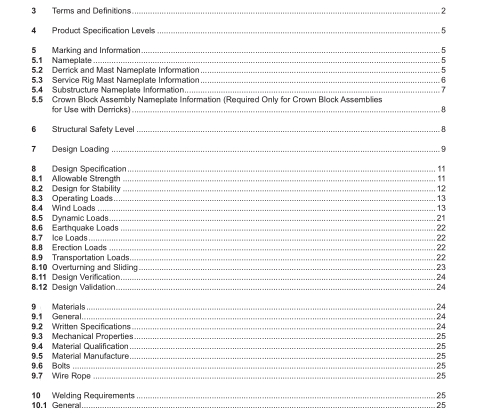API SPEC 4F:2020 pdf free download.Specifcation for Drilling and Well Servicing Structures
8.3 Operating Loads Operating loads shall consist of the following, alone or in combination per Table 2 and as specifed by the purchaser:
a) maximum rated static hook load, in combination with fastline and deadline loads, for each applicable string up condition;
b) maximum rated static rotary load;
c) maximum rated setback load;
d) dead load of drilling structure assembly; e) fuid loads in all piping and tanks incorporated in drilling structures (consideration shall be given to both full and empty tank conditions for stability calculations per 8.10);
f) additional simultaneous or independent loadings as agreed upon by the purchaser and the manufacturer due to ancillary equipment. For all drilling structures, the manufacturer shall include in the rig manual a listing of all items with their total dry and wet weights used in the design. Additionally, the manufacturer shall state the total summation of weights and the frst moment of these weights about the base of the drilling structure for both the dry and wet condition.
8.4 Wind Loads
8.4.1 Design Wind
8.4.1.1 General Each drilling structure shall be designed for the applicable values of design wind as per 8.4. Substructures shall be designed for the same wind speeds as the structures they support. Drilling structures are to be classifed according to their SSL and according to their location: onshore or ofshore. The SSLs for drilling structures refect various degrees of consequence of failure and consider life safety and other issues such as pollution, economic loss, and public concern.
The confguration of the drilling structure during a given wind environment shall be considered. The following wind environments are defned:
a) operational wind—the wind below which unrestricted drilling operations may be continued;
b) erection wind—the wind below which normal rig erection operations may be continued;
c) transportation wind—the wind below which special transportation operations as specifed by the purchaser may be continued;
d) unexpected wind—the wind from a sudden hurricane or storm where time for all preparations is insufcient and setback therefore needs to be considered in the computation of the wind loading;
e) expected wind—the wind from a known hurricane or storm where time is sufcient for preparations, such as lowering the setback.
8.4.1.2 Onshore Wind The design reference wind velocity, V ref , for the operating, erection, and transportation environments shall be as specifed by the purchaser.
For nonoperating design environments on land in the United States, V ref for expected storm conditions shall be obtained from the ASCE/SEI 7–05 wind speed map. For other onshore locations, V ref shall be taken from a source such as a recognized standards agency or a governmental meteorological agency.
The wind velocity chosen shall be a 3-second gust wind, in knots (1 knot = 1.15 mph), measured at 10 m (33 ft) in open terrain with an associated return period of 50 years. For the unexpected wind condition where pipe setback might be racked in the drilling structure, V ref shall be taken as no less than 75 % of the expected storm V ref . For each wind environment, the maximum rated design wind velocity, V des , for various SSLs is then determined by Equation (2), multiplying the design reference wind velocity, V ref , by an onshore multiplier, α onshore , as listed in Table 4 but not less than as specifed in Table 6.
The direction of the wind in all cases may be from any azimuth. The methodology for determining the local wind velocity to be used in the design is discussed in 8.4.1.4.
8.4.1.3 Ofshore Wind The design reference wind velocity, V ref , for the operating, erection, and transportation environments shall be as specifed by the purchaser.API SPEC 4F pdf download.API SPEC 4F:2020 pdf free download
